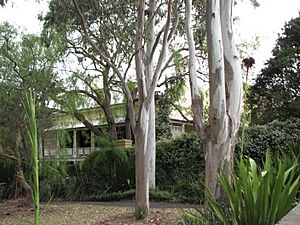Rothwell Lodge and Factory facts for kids
Quick facts for kids Rothwell Lodge and Factory |
|
|---|---|

Rothwell Lodge and Factory, 24 Ferry Road, Glebe, New South Wales
|
|
| Location | 24 Ferry Road, Glebe, City of Sydney, New South Wales, Australia |
| Official name: Rothwell Lodge & Factory | |
| Type | State heritage (built) |
| Designated | 2 April 1999 |
| Reference no. | 591 |
| Type | Historic site |
| Lua error in Module:Location_map at line 420: attempt to index field 'wikibase' (a nil value). | |
The Rothwell Lodge and Factory is an old and important building. It is located at 24 Ferry Road in Glebe, a suburb in Sydney, Australia. This site is listed on the New South Wales State Heritage Register. This means it is protected because of its historical value. The property is privately owned. It was added to the register on April 2, 1999.
Contents
The Story of Rothwell Lodge
Glebe's Early Days
The area around Leichhardt, which includes Glebe, was first home to the Wangal First Nations Peoples. After Europeans arrived in 1788, many Wangal people became sick. They also lost their hunting grounds. This caused their numbers to drop, and they moved further inland.
Over time, the areas near Blackwattle Bay and Rozelle Bay changed a lot. They became places with maritime (sea-related) industries, factories, and homes. This change continues today. Old industrial areas are now being used for new homes and parks.
The first official land grant in Glebe was given to Reverend Richard Johnson in 1789. He was the colony's first chaplain. This grant was for 400 acres (about 160 hectares). The land was called a "Glebe" because it was meant to help support a church minister.
The area had rolling hills and sandstone cliffs. Several creeks, like Blackwattle Creek, flowed through it. There were also large swampy areas. The hills had many eucalyptus trees. The swamps had mangroves and swamp oaks. Blackwattles, a type of tree, grew there too. Blackwattle Bay was named after these trees. Early settlers hunted kangaroos and emus here. They called the area "Kangaroo Ground."
Reverend Johnson's land stayed mostly undeveloped until 1828. Then, the Church and School Corporation divided it into 28 smaller lots. They kept three lots for church use.
How Glebe Grew
In 1828, the Church sold 27 of these lots. The wealthy people liked the point of land near the sea breezes. They built large villas there. The area closer to Broadway attracted industries like slaughterhouses. These businesses used the creek that flowed into Blackwattle Swamp.
Smaller homes for working-class families were built near these industries. From the 1860s, more slaughterhouses were built. The Church owned the middle section of the Glebe Estate until the 1970s.
When Glebe became its own municipality (a local government area) in 1859, there were disagreements among residents. From the 1850s, wealthier people had more influence in Glebe.
Wentworth Park was created in 1882 by reclaiming swamp land. It became a place for cricket and lawn bowls. Rugby union was played there in the late 1800s. Dog racing started there in 1932.
In the early 1900s, many large villas were divided into boarding houses. This happened as wealthier people moved to new suburbs. These suburbs were easier to reach because of new railways.
Until the 1950s, Sydney was a city with many working-class jobs. It was a busy port and industrial center. By the 1960s, central Sydney changed. It became a "corporate city" with more service-based jobs. These jobs needed more capital (money) than labor (workers).
This led to a change in who lived in the inner city. Younger professionals and people in technical jobs wanted to live closer to their work. Old houses were at risk of being torn down. This is when the heritage conservation movement began. The Fish Markets moved into Glebe in the 1970s. Many students also moved to Glebe in the 1960s and 1970s.
About Rothwell Lodge
Rothwell Lodge was built for Reverend William Binnington Boyce. He was a Methodist minister and a friend of George Wigram Allen. Reverend Boyce's second wife, Mary, was Allen's daughter. Records show that Boyce lived at Rothwell Lodge in 1861.
For many years, Rothwell Lodge was used as a lodging house. A shoe-making factory was located at the back of the property. The house was sold in 2014 for $5 million.
What Rothwell Lodge Looks Like
Rothwell Lodge is a two-storey house. It is made of masonry (like brick or stone) with a smooth, rendered finish. It has an iron roof and a dormer window (a window that sticks out from the roof). There is a verandah (a covered porch) on the north and east sides. A new addition has been built on the south side.
Changes Over Time
In the early 1990s, the house was restored by Otto Cserhalmi. He used it as his home and office. During this restoration, dormer windows were added. The restoration was finished, and the house was sold in 2014.
Why Rothwell Lodge is Important
As of December 1, 2004, Rothwell Lodge is one of the oldest houses still standing in Glebe. It was built around the 1840s. Its design is important because it shows the early Victorian Georgian architectural style. It also plays a key role in the look and feel of the townscape. George Allen developed the property for Reverend Boyce.
Rothwell Lodge and Factory was officially listed on the New South Wales State Heritage Register on April 2, 1999.

